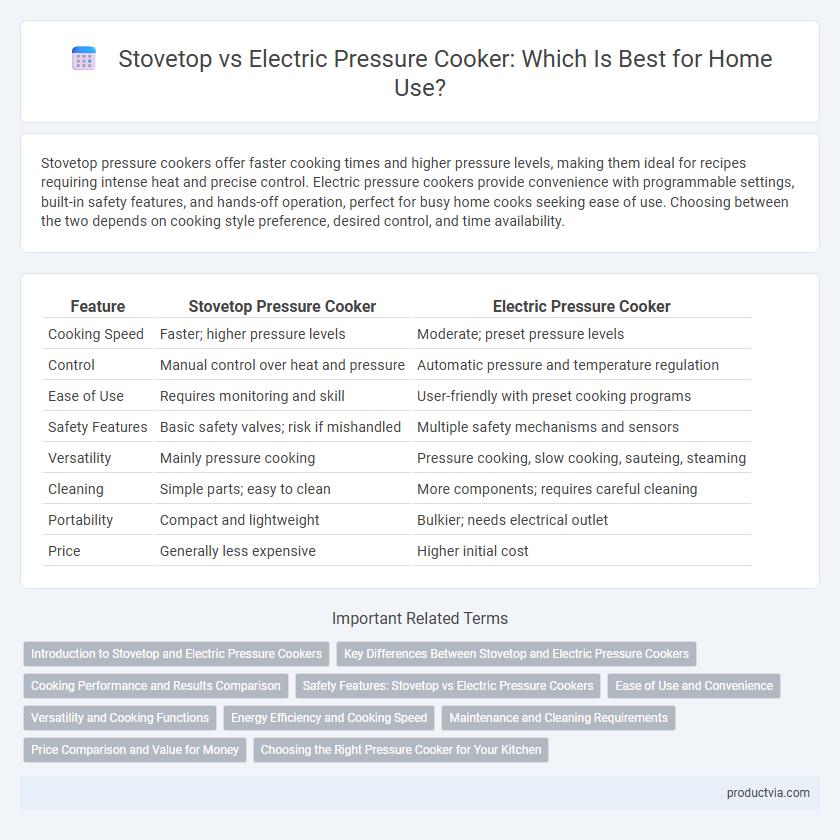Stovetop pressure cookers offer faster cooking times and higher pressure levels, making them ideal for recipes requiring intense heat and precise control. Electric pressure cookers provide convenience with programmable settings, built-in safety features, and hands-off operation, perfect for busy home cooks seeking ease of use. Choosing between the two depends on cooking style preference, desired control, and time availability.
Table of Comparison
| Feature | Stovetop Pressure Cooker | Electric Pressure Cooker |
|---|---|---|
| Cooking Speed | Faster; higher pressure levels | Moderate; preset pressure levels |
| Control | Manual control over heat and pressure | Automatic pressure and temperature regulation |
| Ease of Use | Requires monitoring and skill | User-friendly with preset cooking programs |
| Safety Features | Basic safety valves; risk if mishandled | Multiple safety mechanisms and sensors |
| Versatility | Mainly pressure cooking | Pressure cooking, slow cooking, sauteing, steaming |
| Cleaning | Simple parts; easy to clean | More components; requires careful cleaning |
| Portability | Compact and lightweight | Bulkier; needs electrical outlet |
| Price | Generally less expensive | Higher initial cost |
Introduction to Stovetop and Electric Pressure Cookers
Stovetop pressure cookers are traditional devices made of durable stainless steel or aluminum, known for their high-pressure cooking capability and faster cooking times. Electric pressure cookers offer user-friendly features such as programmable settings, built-in timers, and automatic pressure release, enhancing convenience for home use. Both types efficiently reduce cooking time and retain nutrients, but stovetop models provide more manual control while electric models prioritize ease and preset versatility.
Key Differences Between Stovetop and Electric Pressure Cookers
Stovetop pressure cookers heat up faster, reaching higher pressures of up to 15 psi, which results in shorter cooking times and more precise control over heat levels. Electric pressure cookers offer programmable settings, built-in timers, and automatic pressure regulation, enhancing convenience and safety for home cooks. The choice between them depends on the need for speed and temperature control versus ease of use and multitasking capabilities.
Cooking Performance and Results Comparison
Stovetop pressure cookers typically reach higher pressures (up to 15 psi), resulting in faster cooking times and tender, evenly cooked meals, making them ideal for those seeking efficiency and precise control. Electric pressure cookers generally operate at lower pressure levels (around 10-12 psi) and offer programmable settings, which provide consistent results with less monitoring but slightly longer cooking durations. Both types produce richly flavored dishes, but stovetop models excel in versatility and rapid cooking performance, while electric models prioritize convenience and safety features for everyday home use.
Safety Features: Stovetop vs Electric Pressure Cookers
Stovetop pressure cookers feature robust mechanical safety valves and pressure indicators, allowing users to manually monitor and release pressure, which requires careful attention and experience to operate safely. Electric pressure cookers incorporate multiple automated safety mechanisms, such as lid lock systems, pressure sensors, and temperature controls, reducing the risk of accidents through programmed safeguards. While electric models provide enhanced convenience and consistent safety, stovetop cookers offer greater durability and control but demand more user vigilance.
Ease of Use and Convenience
Stovetop pressure cookers require manual monitoring and adjustments to maintain pressure, making them less convenient for beginners but offering precise control for experienced cooks. Electric pressure cookers feature programmable settings and automatic pressure regulation, enhancing ease of use and freeing users from constant supervision. For home use, electric models provide greater convenience and user-friendly operation, while stovetop versions are preferred by those seeking traditional cooking methods and faster pressure buildup.
Versatility and Cooking Functions
Stovetop pressure cookers offer superior versatility with precise manual pressure control, allowing rapid adjustments for a variety of cooking techniques such as searing, sauteing, and browning. Electric pressure cookers incorporate multiple programmable cooking functions like slow cooking, steaming, and yogurt making, simplifying complex recipes through automated settings. Home cooks benefit from selecting based on their need for hands-on control versus convenience and multifunctionality in meal preparation.
Energy Efficiency and Cooking Speed
Stovetop pressure cookers are known for their superior energy efficiency, as they reach higher temperatures faster and maintain consistent pressure with minimal energy consumption. Electric pressure cookers offer convenient preset cooking programs but generally consume more electricity due to longer preheating and pressure-building times. For home use focused on saving energy and reducing cooking time, stovetop models are typically the more efficient and faster choice.
Maintenance and Cleaning Requirements
Stovetop pressure cookers require careful disassembly of the gasket and valves for thorough cleaning to prevent food buildup and maintain optimal sealing performance. Electric pressure cookers often feature removable, dishwasher-safe inner pots and streamlined lids, simplifying routine maintenance and reducing wear on sealing components. Regular inspection and replacement of rubber gaskets in both types are essential to ensure safety and prolong the appliance's lifespan.
Price Comparison and Value for Money
Stovetop pressure cookers typically cost between $50 and $150, offering durable stainless steel construction and faster cooking times, which appeals to budget-conscious users seeking longevity and high heat control. Electric pressure cookers, priced between $70 and $200, provide convenience with programmable settings and safety features, delivering excellent value for users prioritizing ease of use and multifunctionality. Value for money depends on cooking preferences: stovetop models excel in performance and durability, while electric versions offer versatility and user-friendly automation.
Choosing the Right Pressure Cooker for Your Kitchen
Stovetop pressure cookers heat quickly and offer precise pressure control, making them ideal for experienced cooks who prioritize speed and versatility, while electric pressure cookers provide programmable settings and safety features suited for convenience and consistent results. Consider the kitchen space, cooking habits, and meal preferences when selecting between stovetop and electric models to ensure compatibility with your lifestyle. Key factors include pressure levels, capacity, ease of cleaning, and durability to match your culinary needs and kitchen workflow.
Stovetop Pressure Cooker vs Electric Pressure Cooker for Home Use Infographic

 productvia.com
productvia.com